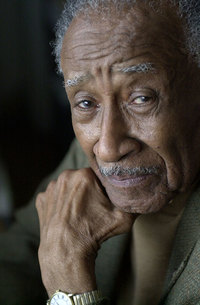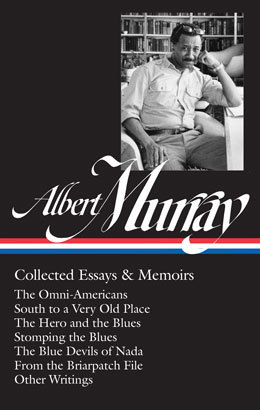In anticipation of its upcoming thirty-fifth anniversary in 2017, Library of America recently asked members of its Advisory Council to identify an American writer or written work that had a transformative impact on them. Historian, author, and LOA Advisor Douglas Brinkley wrote back with the following appreciation of the work of Albert Murray, in particular the “biting logic” and “no-holds barred polemic” of Murray’s first work, The Omni–Americans (1970).
By Douglas Brinkley
The nonfiction books of Albert Murray—which have now been gathered in a Library of America volume—have deeply influenced the way I think about race in America.
Recently, I was given a copy of a 1974 letter of recommendation which Ralph Ellison wrote on behalf of Albert Murray becoming a member of the Century Association. Ellison had become acquainted with Murray when they were book omnivores at Tuskegee University in the mid-1930s. During World War II they were reunited in New York City and became intimate friends. Together, accompanied by their wives, they drove all over Italy, France, and Switzerland, sampling epicurean delights and gossiping about the existentialist philosophy of Sartre and Camus. When Ellison won the National Book Award in 1953 for his novel Invisible Man, Murray was among the first to congratulate him.
Two decades later, in a moment of forgetfulness triggered by the recent death of jazz bandmaster Duke Ellington, Ellison, in his mid-fifties, was tardy in vouching for Murray. “Unfortunately, I find myself guilty of having confused my symbolic action of endorsement with the more prosaic matter of going to my typewriter,” Ellison wrote his fellow Centurions on the first of June. “Nevertheless, after hearing in the bar-room that Murray had been made a candidate I had the distinct impression that I had not only expressed to you with enthusiasm for his candidacy, and in my most eloquent manner, but also in the proper form required for your consideration. Such was the illusion fostered by one of our most august institutions: The Century Martini.”
After mentioning that Murray was a native of Mobile, Alabama, traveled widely as a career Army Air Corps officer during the Eisenhower era, held degrees from Tuskegee and New York University, taught literature and geopolitics and published three excellent nonfiction cultural manifestos—the edgy The Omni-Americans (1970), the sublime South to a Very Old Place (1971), and the 1972 University of Missouri lectures collected as The Hero and the Blues (1973)—Murray, he explained, had a special aptitude for marrying blues–jazz music with literary excellence. Cutting to the chase, Ellison applauded his friend’s belief in improvisation as an inoculation against the booby-traps of life’s uncertainties. Nobody, Ellison explained, absorbed the swing, humor, elegance, love, and stark feeling associated with Negro art with the sophistication of the fifty-four-year-old Murray.
Murray is an enthusiastic conversationalist who possesses an original approach to art and society, and he has a rare ability to relate aspects of American popular and vernacular culture to the literary classics and to the ongoing metamorphosis of humanistic values . . . . One may say without exaggeration that he is one American who is fully conscious of the diverse cultural influences that have formed him, and that not only is he at peace with the forces that make up his pluralistic identity, but he is enraptured by the excitement with which his sense of life endows the turbulent processes of experience. Better still, he manages through his good humor and gift for language to make his friends and acquaintances the beneficiaries of his zest for literature and ideas. In his presence one has an intensified awareness of the wonders of being an American and of one’s good fortune in sharing in the great experiment.
Ellison closed by saying that Murray was “no mere amateur of the arts,” but was “a word-man of unusual ability,” beyond easy categorization. “Although I can’t say that he is as noisy as his present advocate (not having the diaphragm, reflexes, and habits of an ex-trumpet player, how could he be?),” Ellison joked. “I can assure you that wherever Murray is the conversation is sure to be interesting and not infrequently, hilariously witty.”

Murray, the affable and handsome “philosopher of the blues,” was on a hot streak during the Nixon era. His first book, The Omni-Americans, had a highly acclaimed debut in 1970. Combining deep-seated analysis with literary élan, this nonfiction book was an astute, if searing, riposte to both black complacency and black militancy. In this no-holds-barred polemic Murray managed to encapsulate ideas about the Negro experience that had been percolating in his mind since his childhood in Mobile. The Omni-Americans exuded a sense of galloping home after a long up-from-Tuskegee intellectual journey. With biting logic Murray dismissed academic efforts to analyze Negro life through faux-sociological concepts (even those espoused by well-meaning liberals such as Daniel Patrick Moynihan).
What Murray flat-out objected to in the Moynihan Report of 1965 was the “sociological” ghettoizing of the black experience. While Murray accepted the idea that the report offered a window into Harlem dysfunction, it was extremely limited in pedagogical approach. Where were the elegance of Duke Ellington’s “In a Sentimental Mood” or the flashing colors of Romare Bearden’s The Block in this respect? Murray rejected the notion that all blacks felt beaten or victimized. Murray preferred celebrating Negro excellence in the arts than woeful factoids pertaining to high black prison incarceration rates. To Murray black folks could—and had—achieved their individual excellence under repressive conditions. “What Louis Armstrong had been doing in popular songs all these years,” Murray argued, “is an infinitely more accurate index to fundamental U.S. Negro attitudes toward ‘white culture’ than are some of the embarrassingly superficial and contradictory gestures of alienation currently so popular among some black nationalists and ‘Afro-Zionists.’”
The most quoted line in The Omni-Americans, the one that stirred the most controversy in 1970, was “American culture, even in its most rigidly segregated precincts is incontestably mulatto . . . the so-called black and so-called white people of the United States resemble nobody else in the world so much as they resemble each other.” This was a brave argument to make at a time when the Black Panthers were in vogue. “It is a nation of multicolored people,” Murray argued. “There are white Americans so to speak and black Americans. But any fool can see that the white people are not really white and that black people are not black. They are interrelated one way or another.”
Murray had his staunch defenders. Writing in the Tulane Law Review in 1972, novelist Walker Percy, author of The Moviegoer, rightfully determined that The Omni-Americans “may be the most important book on black-white relations in the United States, indeed on American culture, published in this generation.” And while my favorite Murray effort is his essential Stomping the Blues, I agree with Percy and Ellison’s high assessment of The Omni-Americans—a book that changed my way of thinking about American identity.
The author of several works of nonfiction, Douglas Brinkley is a professor of history at Rice University, the CNN Presidential Historian, and a contributing editor at Vanity Fair and Audubon. A member of the Society of American Historians and the Council on Foreign Relations, he edited the Library of America volume Jack Kerouac: Road Novels 1957–1960 and serves on the Library of America Advisory Council.




